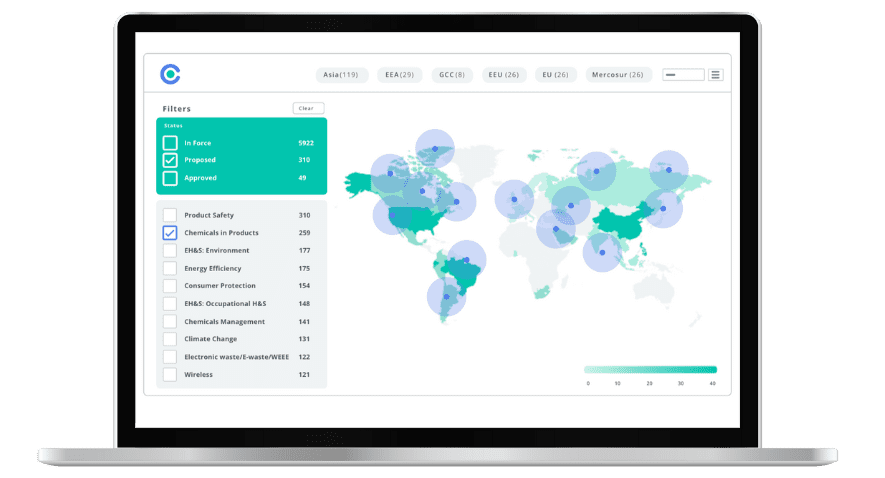
USA – The Search for PFAS: EPA Reporting and Recordkeeping Requirements for PFAS Chemicals under TSCA

This blog was originally posted on 15th May, 2024. Further regulatory developments may have occurred after publication. To keep up-to-date with the latest compliance news, sign up to our newsletter.
AUTHORED BY VICTORIA SMART, SENIOR REGULATORY COMPLIANCE SPECIALIST, COMPLIANCE & RISKS
Introduction
The comprehensive requirements of EPA’s 2023 regulation on reporting and recordkeeping of PFAS (Per- and Polyfluoroalkyl Substances) have triggered questions and concerns for manufacturers and importers. The TSCA-governed reporting rule is structured by the EPA to collect considerable data on manufacture, use, and health effects of PFAS, in the US, during a particular period.
Manufacturers could be facing costs to comply with data collection, reporting and long-term recordkeeping requirements and in tandem facing the risk of sanctions for non-compliance.
In this blog, we outline key requirements.
PFAS Reporting Rule: USA Reporting and Recordkeeping Requirements for Certain Per- and Polyfluoroalkyl Substances, 40 CFR 705, 2023
The EPA published the final rule on October 11, 2023 and the regulation took effect on November 13, 2023. The rule mandates the reporting and recording of the manufacture of PFAS chemical substances in the US during the 12 years prior to 2024.
Persons who manufacture (including import) or have manufactured PFAS chemical substances in any year since January 1, 2011 are to submit information to EPA regarding PFAS: on uses, production volumes, byproducts, disposal, exposures, and existing information on environmental or health effects.
TSCA’s statutory definition of “manufacture” includes “importing” in the USA. The regulation enjoins “articles containing PFAS” to the reporting requirements. EPA regards finished consumer goods placed in commerce (such as toys) generally as “articles”, which if containing PFAS are reportable.
Entities who have not manufactured, and have only processed, distributed in commerce, used, and/or disposed of PFAS, and are not required to report under this rule.
Manufacturers Obligations
The submission and information collection period for all reporters is six months, from November 12, 2024 to May 08, 2025; excepting small business/article reporters from November 12, 2024, through November 10, 2025.
- For the one-time submission, reporters who have manufactured for commercial purposes a chemical substance identified as PFAS, at any period from January 1, 2011 to November 13, 2023, must report for each site of each of the chemical substances identified, “to the extent Known to or Reasonably Ascertainable” (“KRA”).
- Article importers have the option to use a streamlined reporting form, designating the consumer and commercial product category that describes the products in which each PFAS chemical within an imported article is used.
- Domestic purchase of materials containing PFAS does not require reporting; though manufacturing PFAS is clearly reportable. Import of articles, mixtures and products containing PFAS must be reported.
- Each submitter [manufacturer or importer] maintains the records documenting the information reported for a period of 5 years, beginning on the last day of the submission period.
- Packaging is within the scope of the rule.
- Any amount of PFAS known to be manufactured is reportable.
EPA is developing a new reporting tool for this rule on CDX. To avoid duplicates, reporters should notify EPA if they have already submitted specific data.
Defining PFAS
Per- and polyfluoroalkyl substances or PFAS is, for this rule, a chemical substance or mixture containing a chemical substance that structurally contains at least one of the following three sub-structures:
- (1) R-(CF2)-CF(R′)R″, where both the CF2 and CF moieties are saturated carbons.
- (2) R-CF2OCF2-R′, where R and R′ can either be F, O, or saturated carbons.
- (3) CF3C(CF3)R′R″, where R′ and R″ can either be F or saturated carbons.
Fluoropolymers may meet this scope and if confirmed by EPA would be reportable.
Any TSCA chemical substance meeting this definition which has been manufactured in any year since January 1, 2011, is reportable.
Stay Ahead Of Regulatory Changes In PFAS
Accelerate your ability to achieve, maintain & expand market access for all products in global markets with C2P – Your key to unlocking market access, trusted by more than 300 of the world’s leading brands.
C2P is an enterprise SaaS platform providing everything you need in one place to achieve your business objectives by proving compliance in over 195 countries.
C2P is purpose-built to be tailored to your specific needs with comprehensive capabilities that enable enterprise-wide management of regulations, standards, requirements and evidence.
Add-on packages help accelerate market access through use-case-specific solutions, global regulatory content, a global team of subject matter experts and professional services.
- Accelerate time-to-market for products
- Reduce non-compliance risks that impact your ability to meet business goals and cause reputational damage
- Enable business continuity by digitizing your compliance process and building corporate memory
- Improve efficiency and enable your team to focus on business critical initiatives rather than manual tasks
- Save time with access to Compliance & Risks’ extensive Knowledge Partner network

Chemicals Quarterly – Q1 Regulatory Update 2024
An overview of the latest news on permitted, restricted and prohibited substances in a variety of products from around the world.


